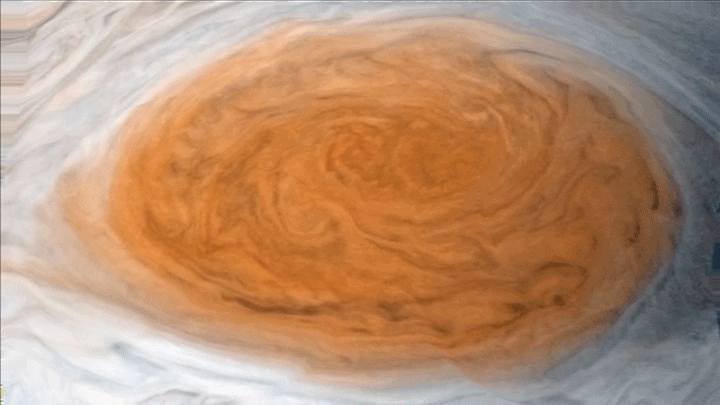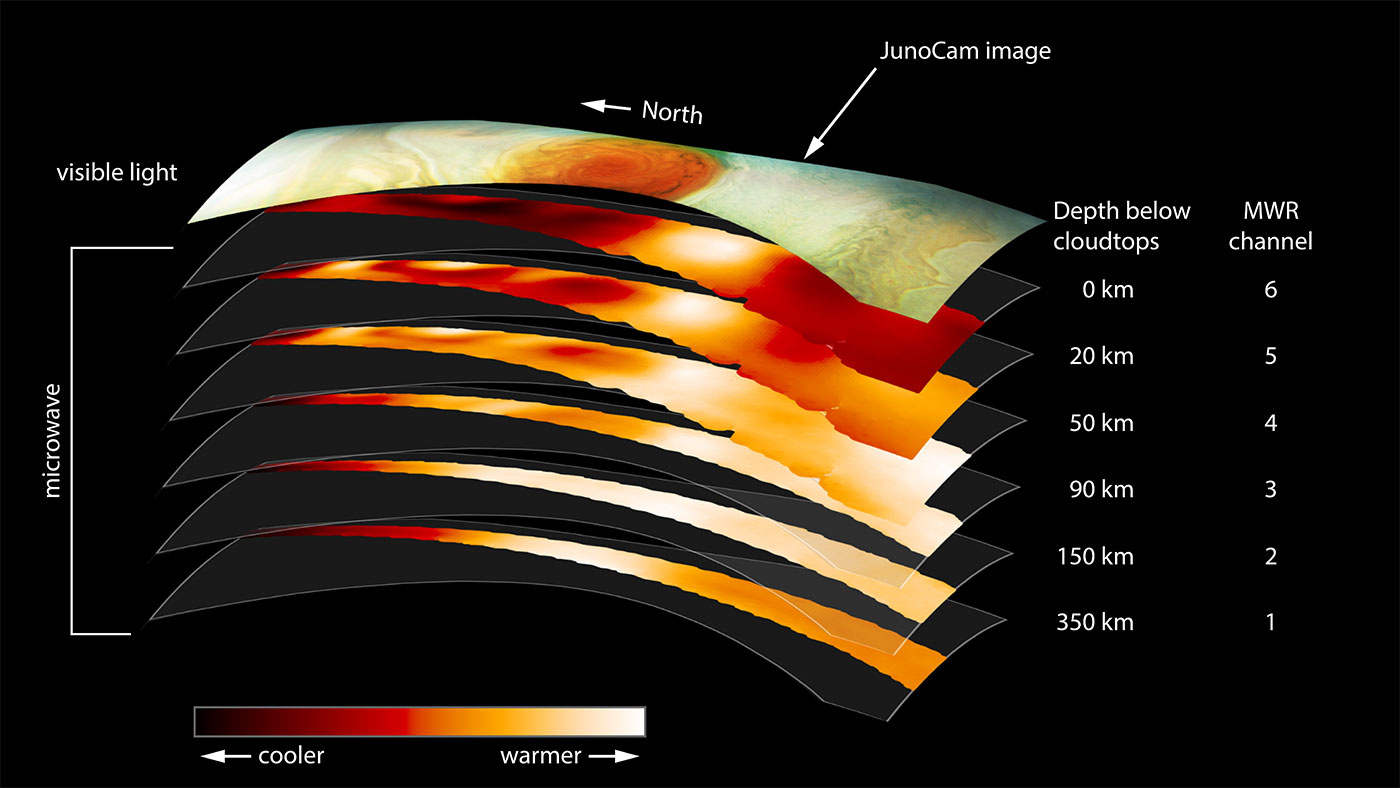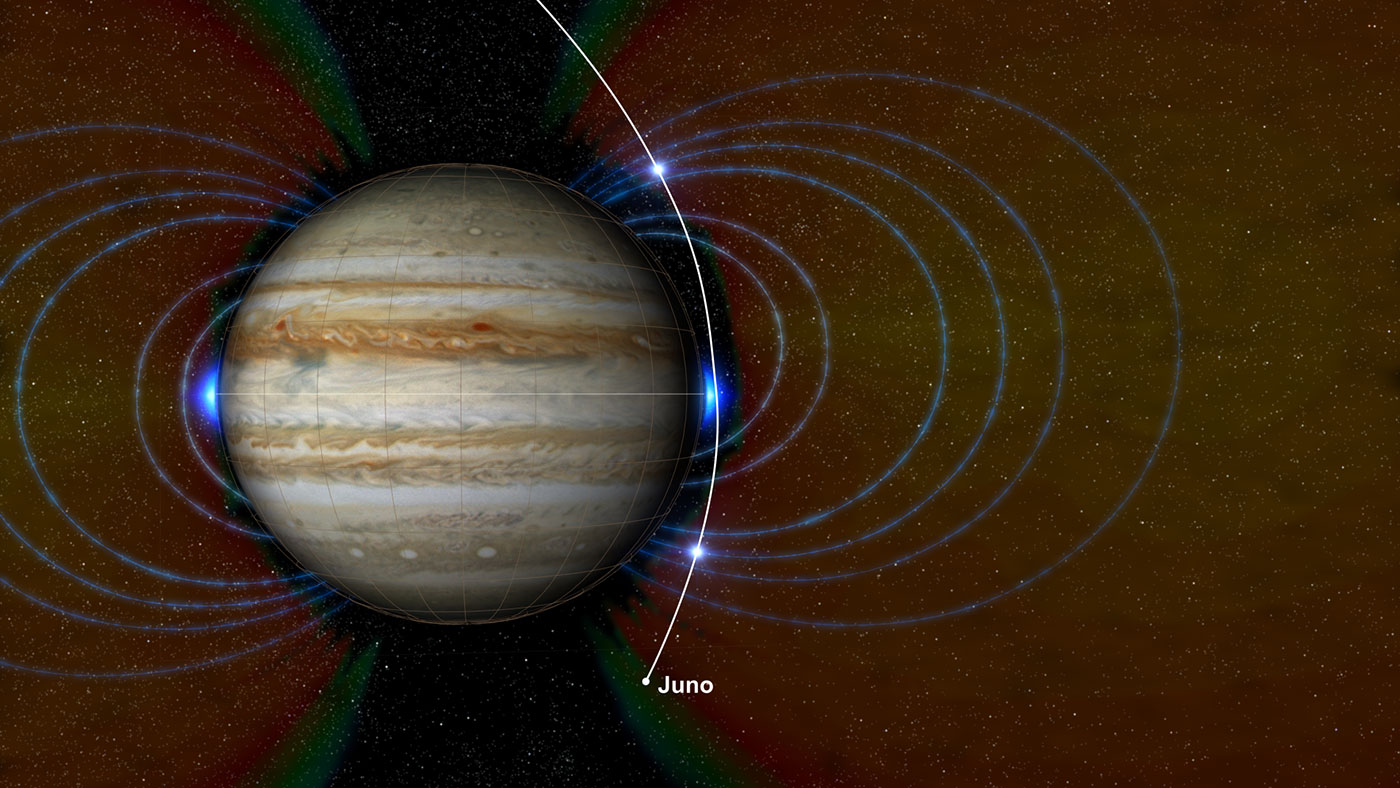Jupiter's Great Red Spot Is More Than 50 Times Deeper Than Earth's Ocean
NASA's Juno spacecraft is getting to the roots of Jupiter's famous Great Red Spot. New research, collected during the mission's first pass over the iconic storm, reveals that it extends far beneath the planet's surface. The spacecraft also discovered two newly identified radiation zones.
"One of the most basic questions about Jupiter's Great Red Spot is, how deep are the roots?" Juno principal investigator Scott Bolton, of the Southwest Research Institute in San Antonio, said in a statement. Bolton and his team presented Juno's results at the American Geophysical Union meeting in New Orleans yesterday (Dec. 11).
"Juno data indicate that the solar system's most famous storm is almost one-and-a-half Earths wide, and has roots that penetrate about 200 miles [300 kilometers] into the planet's atmosphere," Bolton said. [Jupiter's Great Red Spot: An Iconic Monster Storm in Pictures]

A slowly shrinking storm
Despite being long-lived, Jupiter's Great Red Spot hasn't been a model of consistency. While the massive feature has swirled across Jupiter for at least 200 years — possibly 350, if early telescope observations describe the same storm — it has been slowly shrinking. During the 19th century, and again when NASA's Voyager 1 and 2 spacecraft sped by on the way to Saturn in 1979, the spot stretched well over two Earths wide. But Earth-based measurements today put the spot at only a third of the size measured by the Voyager probes.
Juno arrived at Jupiter on July 4, 2016, after a nearly five-year flight. Since then, the spacecraft has made eight science passes over the gas giant, with a ninth scheduled for this Saturday (Dec. 16). In July 2017, it made its first close flyby of the Great Red Spot. The spacecraft's Microwave Radiometer probed the clouds surrounding the gigantic storm, measuring their depth in the atmosphere.

"Juno found that the Great Red Spot's roots go 50 to 100 times deeper than Earth's oceans and are warmer at the base than they are at the top," said Andy Ingersoll, a professor of planetary science at Caltech and a Juno co-investigator. "Winds are associated with differences in temperature, and the warmth of the spot's base explains the ferocious winds we see at the top of the atmosphere."

Juno also discovered two new radiation bands. One lies just above the equator of the gas giant's atmosphere and includes hydrogen, oxygen and sulfur ions moving at near light speed. [Great Red Spot, Spotted! Citizens Create Incredible Images of Jupiter Storm]
Get the Space.com Newsletter
Breaking space news, the latest updates on rocket launches, skywatching events and more!
"We knew the radiation would probably surprise us, but we didn't think we'd find a new radiation zone that close to the planet," said Heidi Becker, Juno's radiation monitoring investigation lead at NASA's Jet Propulsion Laboratory. "We only found it because Juno's unique orbit around Jupiter allows it to get really close to the cloud tops during science collection flybys, and we literally flew through it."
Identified by the spacecraft's Jupiter Energetic Particle Detector Instrument, the charged particles are thought to come from fast-moving neutral atoms created in the gas around Jupiter's moons Europa and Io, NASA officials said in the statement. As the particles interact with Jupiter's atmosphere, their electrons are stripped away, giving them a charge.
Juno also found a second charged region around the planet's high latitudes, in realms never before explored by any spacecraft. The origin of these particles, which were detected by Juno's Stellar Reference Unit star camera, remains a mystery.
"The closer you get to Jupiter, the weirder it gets," Becker said.
Editor's Note: This article was corrected to reflect that an atom's electrons being stripped away would give the atom a positive charge, not a negative charge.
Follow Nola Taylor Redd on Twitter @NolaTRedd or Google+. Follow us at @Spacedotcom, Facebook or Google+. Originally published on Space.com.
Join our Space Forums to keep talking space on the latest missions, night sky and more! And if you have a news tip, correction or comment, let us know at: community@space.com.

Nola Taylor Tillman is a contributing writer for Space.com. She loves all things space and astronomy-related, and enjoys the opportunity to learn more. She has a Bachelor’s degree in English and Astrophysics from Agnes Scott college and served as an intern at Sky & Telescope magazine. In her free time, she homeschools her four children. Follow her on Twitter at @NolaTRedd









